Dangers
- Carbon monoxide poisoning
- Burns
- Toothpick
- Paintbrush
Tools needed
If in doubt call a Professional!!
Gas cookers and hobs
READ THE DANGERS SECTION
The idea of this is so you get an idea of your cooker, so you know if your engineer is doing his job correctly, if you attempt a service yourself,be careful
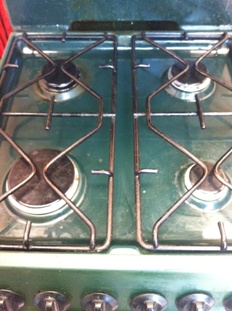
Initialy we will start by looking at the burners. There are several types, but the principal is always the same.
lets look at the problems you may be having. Yellow flames, wavy flames, uneven burning, some jets sections of burner not working, or small flames. This is usualy all down to food debris in the burner or jets. A correctly operating burner flame looks like my header picture, even, sharp, well defined blue flames.
Now remove ONE burner assembly at a time by simply lifting it off. You will see its in two or more parts. Look closely at how they align, and the 'locating' pins.
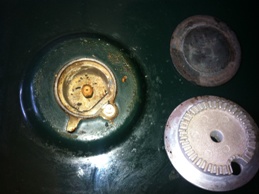
Now its appart, inspect closely. Look into the jet orifice for blockages, look for debris around the jet, and inspect the burner head. The head shown here is a 'slot' type, some have a row of holes, some have two rows. Either way, they need to be clean and clear.
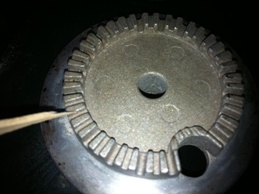
Get a small wooden stick, a toothpick or a cut down stirrer is fine, and clear the burner head. Washing it in the sink is a good idea, but that is unlikely to clear it all. As a guide, holes are either square or round, and of uniform size, so any 'odd' ones are partialy blocked. DO NOT be tempted to use any harsh chemicals, abrasives, metal spikes, wire etc, as you will end up enlarging the holes, and it will burn even worse.
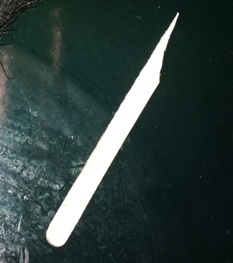
The jet itself is often blocked, either partialy or fully. My favorite way to clean these is a Mcdonalds tea stirrer cut diagonaly to give a sharp point. This is good as you get a very long point, as the grain of the wood is along the stick. Most blockages are high up in the jet, so easy to remove.
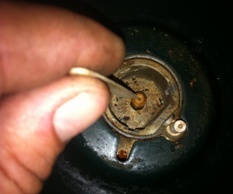
Gently place the tip of your chosen pointy peice of wood into the jet orifice, straight down, not at an angle as i am, and rotate between finger and thumb. Do not press too hard or you will be left with a splinter of wood in the jet! (if this does happen use tweezers to remove it) The reason I like the Mcdonalds tea stirrer is it usualy wont break completely, so you can snap the tip inside the jet, and it stays attatched to the main bit. Im not sure if other fast food outlets have the same quality of stirrer! Seriously blocked jets can be cleared by removing the jet, and boiling in clean water for 45 minutes. This is for a qualified gas engineer to do, not a homeowner.
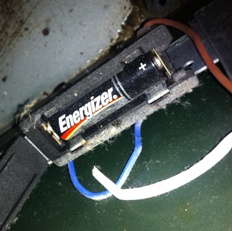
Most cookers have an electronic ignition. It will either be battery powered or 240v mains. To discover which, see if you have a 240v cable to the cooker, if so, its not likely to be battery powered. Batteries can easily be changed, 9v or 1.5v is usual, mine here is a single AA battery. Look to fit a low power long life battery, not a high powered 'camera type' battery. The battery pack will always be located low down, usualy under the oven, or in the bottom compartment, to keep it out of the heat.
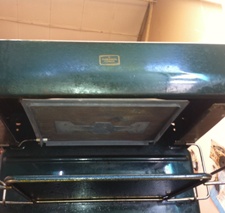
A grill is, in basic terms, a large, downward facing burner. Sure its bigger, and has more holes, but the principal is the same. Most grills have a wire mesh or corrugated metal 'frets' the thing to look out for here is distortion, corrosion or blackening of the frets or mesh. Grills can be lethal, and burning badly can easily produce enough carbon monoxide to kill you. Again the flame must be blue and even, no wavy sections, yellow flames and carbon or soot build up. Some grills have ceramic inserts, these should not be touched as they break easily, some are literaly long cast iron burners, with holes to clean like a burner. Assuming the burner section is ok, lets look at other possible problems.
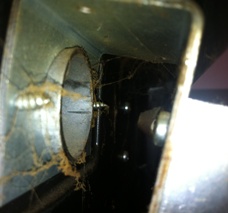
A grill has a jet, just like a burner, but harder to get at. In most cases the jet is behind the cooker. Notice how the jet 'sprays' gas into the burner hole? this is to entrain primary air into the gas as it enters the burner, to give a full gas/air mix. Look for lint and fluff in the primary air inlet, fluff on the jet, or chunks of lint stuck in the air tube.
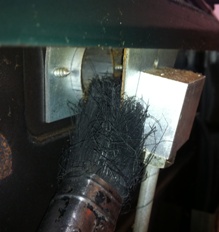
A paintbrush is the best tool to clear it with, usualy the cheaper the better. A cheap brush has stiffer bristles that dont taper at the ends, and wont fluff up, like the harris brush pictured.
Your grill flame picture should be blue, even and stable, if its not, DONT USE IT!
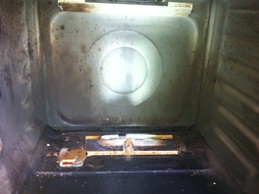
The oven burner is a slightly different animal. Get all the shelves out and take a look. (oven OFF) Your looking for food debris in the burner slots, half a pizza in the jet etc.
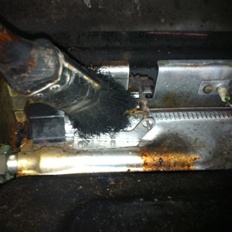
Clear obstructions with the paintbrush, or use the stirrer if its stubborn. Pay attention the ignitor probe and alchol phial that cross over the burner, damage or dislodge these at your own peril!
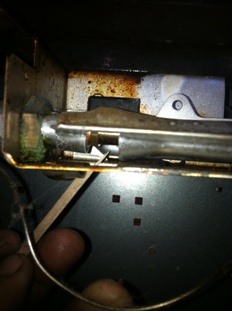
Inspect the burner from underneath and you will see the main jet and primary air venturi, as before, look for lint and deposits of food.
On relighting the oven, look for well defined blue flames, with little or no yellow. Set the oven to 'high' and check that the flame lifts, then turn back to low, close the oven door and wait for 10 minutes, reopen and check the flame has dropped to 'simmer'.
IF IN DOUBT, CALL A PROFESSIONAL, GAS APPLIANCES CAN KILL
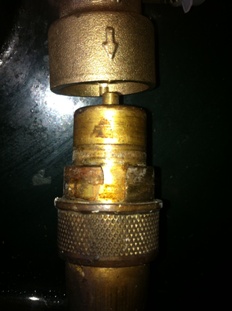
To disconnect your cooker, trace the black gas hose back to the connection on the wall. You will see a knurled section where it joins the wall outlet (called 'bayonet'). Squeeze the knurled nut into the bayonet, rotate anticlockwise by 1/4 a turn, then wiggle the hose free. Homeowners - you ARE allowed to do this. The bayonet fixing is self sealing, so no gas should escape.

Broken cooker knobs can usualy be fixed with chemical metal - 'plastic padding' or the like. remake the broken piece in a basic fashion, rub a little olive oil on the brass shaft it sits on and slide it back on, this lets it mould to the perfect shape, but means it doesnt stick to the shaft.
Cooker Notes
- As a rule of thumb, a cooker needs to be in a room with an openable door or window.
- A hob must NEVER be connected to a flexible hose
- A cooker MUST have a stability bracket or chain
- Cookers in flats or HMO's must have flame supervision devices
- Most parts are available for cookers made by 'known' brands. just google your cookers model number.
